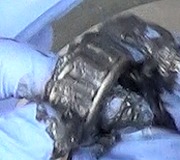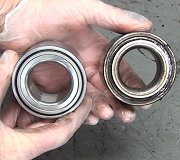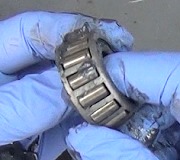"Toe" refers to the direction a wheel is steering when the steering wheel is straight and centered. It is viewed by looking down from on top of the vehicle. If you're seeing what looks like the top is tipped in, that's "camber". It's viewed from in front or rear of the vehicle, looking back at the wheel. Camber will not cause a vibration when it is not set to specs. If the wheel is tipped in too far, you'll have accelerated tire wear on the inner edge of just that one tire. Camber could also be wrong on the other wheel, then that tire would also have bad tire wear, but with camber, each tire 's wear is related to just its adjustment.
Toe is a different story. By adding the values for toe on each front wheel, you get "total toe". Total toe always affects both wheels equally, even when just one wheel is misadjusted. When just one wheel is adjusted wrong, the steering wheel will be off-center when you're driving straight ahead.
One other important point about camber is a tire wants to roll in the direction it's leaning.
We set both wheels to the same value so their pulls offset each other, then we make the left one a little more positive, meaning leaning out on top, to offset "road crown". That's the tilt of the road to the right to make water run off. If one wheel is set a little higher positive than the other one, the vehicle will pull toward that wheel with the higher camber. The amount of that misadjustment is way too small to see by eye. If you can actually see a wheel tipped in or out too far, you should either have a horrendous pull that way that makes your arms tired, or you're seeing the results of some other variable, such as that wheel is sitting on unlevel ground.
So there's two things to look at related to camber. Does the car go basically straight when you let go of the steering wheel? And do you see more tread wear on one edge of the tread than on the rest of that tire? The tire wear takes some mileage to show up. If it looks okay but the car does pull to, in this case, the right, the alignment may have shifted recently. When the shift is bad enough, you may have to tug the steering wheel the other way to keep the vehicle going straight, That results in the steering wheel being turned by you, but that is not the same as an off-center steering wheel. I know that can be confusing, but it is the clues we look for on a pre-alignment test drive.
Misadjusted total toe can cause a pull too, but in a different way, and the handling characteristics are different as well as the feel of that pull. That's a story for another day.
This photo shows your front strut with the two lower mounting holes that attach it to the spindle. Chrysler uses a similar design on many of their older models. They have an elongated lower hole, (red arrow), and they use a special "cam bolt" with an offset head that sits in a pocket. That pocket helps hold the strut tightly to the spindle. By loosening the two bolts and turning the cam bolt, it causes the strut and wheel to tip in or out, then the pocket helps to hold the adjustment from slipping when you hit potholes or other bumps.
GM vehicles do not come with that lower hole elongated from the factory. If camber needs to be adjusted, that lower hole has to be ground to an oval by the alignment specialist to make it adjustable. Once that is done, there is nothing other than the tightness of the bolt to hold the adjustment firmly in place. It's not uncommon to have one slip when you hit something substantial, like a pothole.
One more interesting observation has to do with toe when camber slips. Due to the geometric relationship of the steering and suspension parts, when camber changes, it causes toe to change a real lot on that wheel. The opposite is not true, so we always adjust camber first on both wheels, then the last adjustments on any alignment are for toe on both front wheels. Because toe changes if camber slips, the results, besides possibly a noticeable pull, is to bring toe back to where it's equal on both wheels, you have to turn the steering wheel. To say that a different way, if you think camber may have shifted recently, along with a new pull to one side, and later some noticeable tire wear on one edge of one tire, you'll also see the steering wheel is no longer centered. There are a few models here and there that this doesn't apply to, but it holds true for 99 percent of car models.
Do any of these observations or clues seem to apply to your car? If not, and the only thing you see is what appears to be a leaning wheel, it may be an optical illusion. The next thing then is to look at chassis ride height. This is an issue of age, not mileage. It's the results of the coil springs becoming weak. The people at every tire and alignment shop have a small book that lists every car brand, model, and year, shows where to take the measurements, and what they should be. They're usually happy to show you the illustrations for your car.
This was more critical on older, heavy, rear-wheel-drive cars and trucks that used upper and lower control arms. With sagged ride height, camber could be readjusted to specs, but due to the change in geometry, the tires would still have terrible tire wear even when all the numbers on the alignment computer looked perfect. Cars with strut suspension, like yours, are more forgiving, but still can suffer some ill effects from low ride height. If one coil spring is considerably weaker than the other one, the car body will lean to one side, and that can be enough to see by eye. That can make a wheel appear to be leaning.
Alignment specialists get very picky about correct ride height before attempting to align a car. They'll want to correct it first. That involves replacing the front coil springs which can be a somewhat dangerous job. A better alternative is to replace the entire strut as an assembly as shown in the photo. You get a new strut, coil spring, upper strut mount with the three nuts, and a new accordion boot to keep out dirt. The complete assembly costs only a little more than just the strut by itself, but you save on the labor since all the difficult and dangerous work is already done. You typically end up with a higher quality job at a lower cost. At the mileage you listed, your car might not be ready for new struts yet, but as I mentioned, coil springs get weak from age, not mileage.
An alignment is not necessary after replacing wheel bearings as that doesn't affect any of the adjustments. To address your comment about a vibration, that has to be caused by something that is rotating. An out-of-balance tire will be felt at higher speeds, usually on the highway. A tire with a broken belt can be felt already at real low speeds, and may show up as a slight steering wheel oscillation back and forth when driving very slowly, as in a parking lot. Vibrations from many broken belts go away at higher speeds, while badly broken belts cause a pounding that gets worse the faster you go.
In very rare cases badly misadjusted total toe can cause a vibration, but there will be other symptoms. The wheels are steering in different directions. The one with the least weight on it will tend to walk toward or away from the car until the sidewalls can't stretch any more, then the tread suddenly jumps back ,then the walking away starts all over agin. That walking, then sliding back, can be felt as a vibration in the steering wheel. You won't feel that at lower speeds. It shows up eventually as cupping on the tread, meaning uneven surfaces. That total toe wear always affects both tires nearly equally, even though only one might be misadjusted.
I haven't mentioned anything about a brake pedal pulsation yet, but I suspect that is not the issue here. You might check out these articles for more information:
https://www.2carpros.com/articles/steering-wheel-shakes-when-accelerating-or-braking
https://www.2carpros.com/articles/how-to-replace-a-suspension-strut-and-spring
The strut has a different design for the lower attachments, but the procedure is similar to that for your car.
If you aren't sure yet, have the steering and suspension systems inspected at a tire and alignment shop. The people there are experts at finding the causes of vibrations, bad tire wear, pulling, and noises. Many shops do these inspections at no charge. Tell me what they find or what you find after checking these things out.
Thursday, January 12th, 2023 AT 8:02 PM



